Adult-Acquired Flatfoot Deformity: Combined Talonavicular Arthrodesis and Calcaneal Displacement Osteotomy versus Double Arthrodesis
Abstract
:1. Introduction
2. Patients and Methods
2.1. Population
2.1.1. Inclusion and Exclusion Criteria
2.1.2. Exclusion Criteria
2.2. Surgical Procedure
2.3. Rehabilitation Protocol
2.4. Assessment Methods
2.5. Statistical Analysis
3. Results
Complications
4. Discussion
Limitations
5. Conclusions
Author Contributions
Funding
Institutional Review Board Statement
Informed Consent Statement
Data Availability Statement
Acknowledgments
Conflicts of Interest
References
- Kohls-Gatzoulis, J.; Woods, B.; Angel, J.C.; Singh, D. The prevalence of symptomatic posterior tibialis tendon dysfunction in women over the age of 40 in England. Foot Ankle Surg. 2009, 15, 75–81. [Google Scholar] [CrossRef] [PubMed]
- Federer, A.E.; Steele, J.R.; Dekker, T.J.; Liles, J.L.; Adams, S.B. Tendonitis and Tendinopathy: What Are They and How Do They Evolve? Foot Ankle Clin. 2017, 22, 665–676. [Google Scholar] [CrossRef] [PubMed]
- Giza, E.; Cush, G.; Schon, L.C. The flexible flatfoot in the adult. Foot Ankle Clin. 2007, 12, 251–271. [Google Scholar] [CrossRef] [PubMed]
- Petersen, W.; Hohmann, G.; Pufe, T.; Tsokos, M.; Zantop, T.; Paulsen, F.; Tillmann, B. Structure of the human tibialis posterior tendon. Arch. Orthop. Trauma Surg. 2004, 124, 237–242. [Google Scholar] [CrossRef] [PubMed]
- Bluman, E.M.; Myerson, M.S. Stage IV posterior tibial tendon rupture. Foot Ankle Clin. 2007, 12, 341–362. [Google Scholar] [CrossRef]
- Raikin, S.M.; Winters, B.S.; Daniel, J.N. The RAM classification: A novel, systematic approach to the adult-acquired flatfoot. Foot Ankle Clin. 2012, 17, 169–181. [Google Scholar] [CrossRef]
- Myerson, M.S.; Thordarson, D.B.; Johnson, J.E.; Hintermann, B.; Sangeorzan, B.J.; Deland, J.T.; Schon, L.C.; Ellis, S.J.; de Cesar Netto, C. Classification and Nomenclature: Progressive Collapsing Foot Deformity. Foot Ankle Int. 2020, 41, 1271–1276. [Google Scholar] [CrossRef]
- Peterson, K.S.; Overley, B.D., Jr.; Beideman, T.C. Osteotomies for the Flexible Adult Acquired Flatfoot Disorder. Clin. Podiatr. Med. Surg. 2015, 32, 389–403. [Google Scholar] [CrossRef]
- Ceccarini, P.; Rinonapoli, G.; Gambaracci, G.; Bisaccia, M.; Ceccarini, A.; Caraffa, A. The arthroereisis procedure in adult flexible flatfoot grade IIA due to insufficiency of posterior tibial tendon. Foot Ankle Surg. 2018, 24, 359–364. [Google Scholar] [CrossRef]
- Fadle, A.A.; El-Adly, W.; Attia, A.K.; Mohamed, M.M.; Mohamadean, A.; Osman, A.E. Double versus triple arthrodesis for adult-acquired flatfoot deformity due to stage III posterior tibial tendon insufficiency: A prospective comparative study of two cohorts. Int. Orthop. 2021, 45, 2219–2229. [Google Scholar] [CrossRef]
- Moore, B.E.; Wingert, N.C.; Irgit, K.S.; Gaffney, C.J.; Cush, G.J. Single-incision lateral approach for triple arthrodesis. Foot Ankle Int. 2014, 35, 896–902. [Google Scholar] [CrossRef] [PubMed]
- Johnson, K.A.; Strom, D.E. Tibialis posterior tendon dysfunction. Clin. Orthop. Relat. Res. 1989, 239, 196–206. [Google Scholar] [CrossRef]
- So, E.; Reb, C.W.; Larson, D.R.; Hyer, C.F. Medial Double Arthrodesis: Technique Guide and Tips. J. Foot Ankle Surg. 2018, 57, 364–369. [Google Scholar] [CrossRef] [PubMed]
- Johnson, J.E.; Yu, J.R. Arthrodesis techniques in the management of stage II and III acquired adult flatfoot deformity. Instr. Course Lect. 2006, 55, 531–542. [Google Scholar] [CrossRef] [Green Version]
- Malik, A.; Grant, E.; Rhodenizer, J. Analysis of Micromotion in a Talonavicular Arthrodesis With and Without a Calcaneal Displacement Osteotomy in a Cadaver Model. J. Foot Ankle Surg. 2020, 59, 91–94. [Google Scholar] [CrossRef]
- Fraser, T.W.; Kadakia, A.R.; Doty, J.F. Complications and Early Radiographic Outcomes of Flatfoot Deformity Correction With Metallic Midfoot Opening Wedge Implants. Foot Ankle Orthop. 2019, 4, 2473011419868971. [Google Scholar] [CrossRef] [PubMed]
- Wang, C.S.; Tzeng, Y.H.; Lin, C.C.; Chang, M.C.; Chiang, C.C. Comparison of screw fixation versus non-fixation in dorsal opening wedge medial cuneiform osteotomy of adult acquired flatfoot. Foot Ankle Surg. 2020, 26, 193–197. [Google Scholar] [CrossRef]
- Osman, A.E.; El-Gafary, K.A.; Khalifa, A.A.; El-Adly, W.; Fadle, A.A.; Abubeih, H. Medial displacement calcaneal osteotomy versus lateral column lengthening to treat stage II tibialis posterior tendon dysfunction, a prospective randomized controlled study. Foot 2021, 47, 101798. [Google Scholar] [CrossRef]
- van der Krans, A.; Louwerens, J.W.; Anderson, P. Adult acquired flexible flatfoot, treated by calcaneocuboid distraction arthrodesis, posterior tibial tendon augmentation, and percutaneous Achilles tendon lengthening: A prospective outcome study of 20 patients. Acta Orthop. 2006, 77, 156–163. [Google Scholar] [CrossRef]
- Naal, F.D.; Impellizzeri, F.M.; Huber, M.; Rippstein, P.F. Cross-cultural adaptation and validation of the Foot Function Index for use in German-speaking patients with foot complaints. Foot Ankle Int. 2008, 29, 1222–1228. [Google Scholar] [CrossRef]
- Filardi, V. Flatfoot and normal foot a comparative analysis of the stress shielding. J. Orthop. 2018, 15, 820–825. [Google Scholar] [CrossRef] [PubMed]
- Schon, C.L.; de Cesar Netto, C.; Day, J.; Deland, J.T.; Hintermann, B.; Johnson, J.E.; Myerson, M.S.; Sangeorzan, B.J.; Thordarson, D.B.; Ellis, S.J. Consensus for the Indication of a Medializing Displacement Calcaneal Osteotomy in the Treatment of Progressive Collapsing Foot Deformity. Foot Ankle Int. 2020, 41, 1282–1285. [Google Scholar] [CrossRef]
- Kim, J.; Kim, J.B.; Lee, W.C. Outcomes of Joint Preservation Surgery in Valgus Ankle Arthritis Without Deltoid Ligament Insufficiency. Foot Ankle Int. 2021, 42, 10711007211016001. [Google Scholar] [CrossRef] [PubMed]
- Ebaugh, M.P.; Larson, D.R.; Reb, C.W.; Berlet, G.C. Outcomes of the Extended Z-Cut Osteotomy for Correction of Adult Acquired Flatfoot Deformity. Foot Ankle Int. 2019, 40, 914–922. [Google Scholar] [CrossRef] [PubMed]
- Jeng, C.L.; Bluman, E.M.; Myerson, M.S. Minimally invasive deltoid ligament reconstruction for stage IV flatfoot deformity. Foot Ankle Int. 2011, 32, 21–30. [Google Scholar] [CrossRef]
- Bolt, P.M.; Coy, S.; Toolan, B.C. A comparison of lateral column lengthening and medial translational osteotomy of the calcaneus for the reconstruction of adult acquired flatfoot. Foot Ankle Int. 2007, 28, 1115–1123. [Google Scholar] [CrossRef] [PubMed]
- Catanzariti, A.R.; Adeleke, A.T. Double arthrodesis through a medial approach for end-stage adult-acquired flatfoot. Clin. Podiatr. Med. Surg. 2014, 31, 435–444. [Google Scholar] [CrossRef] [PubMed]
- Fornaciari, P.; Gilgen, A.; Zwicky, L.; Horn Lang, T.; Hintermann, B. Isolated talonavicular fusion with tension band for Muller-Weiss syndrome. Foot Ankle Int. 2014, 35, 1316–1322. [Google Scholar] [CrossRef]
- Peng, Y.; Niu, W.; Wong, D.W.; Wang, Y.; Chen, T.L.; Zhang, G.; Tan, Q.; Zhang, M. Biomechanical comparison among five mid/hindfoot arthrodeses procedures in treating flatfoot using a musculoskeletal multibody driven finite element model. Comput. Methods Programs Biomed. 2021, 211, 106408. [Google Scholar] [CrossRef]
- Vacketta, V.G.; Jones, J.M.; Philp, F.H.; Saltrick, K.R.; McMillen, R.L.; Hentges, M.J.; Catanzariti, A.R. Radiographic Outcomes of Talonavicular Joint Arthrodesis with Varying Fixation Techniques in Stage III Adult Acquired Flatfoot Reconstruction. J. Foot Ankle Surg. 2021. ahead of print. [Google Scholar] [CrossRef]
- Flores, D.V.; Mejia Gomez, C.; Fernandez Hernando, M.; Davis, M.A.; Pathria, M.N. Adult Acquired Flatfoot Deformity: Anatomy, Biomechanics, Staging, and Imaging Findings. Radiographics 2019, 39, 1437–1460. [Google Scholar] [CrossRef] [PubMed] [Green Version]
- Vlachou, M.; Dimitriadis, D. Results of triple arthrodesis in children and adolescents. Acta Orthop. Belg. 2009, 75, 380–388. [Google Scholar] [PubMed]
- Fuhrmann, R.A.; Pillukat, T. Subtalar arthrodesis. Oper. Orthop. Traumatol. 2016, 28, 177–192. [Google Scholar] [CrossRef]
- Ma, S.; Jin, D. Isolated Talonavicular Arthrodesis. Foot Ankle Int. 2016, 37, 905–908. [Google Scholar] [CrossRef] [PubMed]
- Burrus, M.T.; Werner, B.C.; Carr, J.B.; Perumal, V.; Park, J.S. Increased Failure Rate of Modified Double Arthrodesis Compared With Triple Arthrodesis for Rigid Pes Planovalgus. J. Foot Ankle Surg. 2016, 55, 1169–1174. [Google Scholar] [CrossRef]
- Saxena, A.; Patel, R. Medial Displacement Calcaneal Osteotomy: A Comparison of Screw Versus Locking Plate Fixation. J. Foot Ankle Surg. 2016, 55, 1164–1168. [Google Scholar] [CrossRef]
- Haggerty, E.K.; Chen, S.; Thordarson, D.B. Review of Calcaneal Osteotomies Fixed With a Calcaneal Slide Plate. Foot Ankle Int. 2020, 41, 183–186. [Google Scholar] [CrossRef]
- Lucas, D.E.; Simpson, G.A.; Berlet, G.C.; Philbin, T.M.; Smith, J.L. Screw size and insertion technique compared with removal rates for calcaneal displacement osteotomies. Foot Ankle Int. 2015, 36, 395–399. [Google Scholar] [CrossRef]
- Ferreira, G.F.; Nava, N.; Durigon, T.S.; Dos Santos, T.F.; Pereira Filho, M.V. Double hindfoot arthrodesis using a single-incision medial approach in the correction of adult-acquired flatfoot deformity: A case series. Int. Orthop. 2021, 45, 2375–2381. [Google Scholar] [CrossRef]
- Tejero, S.; Carranza-Perez-Tinao, A.; Zambrano-Jimenez, M.D.; Prada-Chamorro, E.; Fernandez-Torres, J.J.; Carranza-Bencano, A. Minimally invasive technique for stage III adult-acquired flatfoot deformity: A mid- to long-term retrospective study. Int. Orthop. 2021, 45, 217–223. [Google Scholar] [CrossRef]
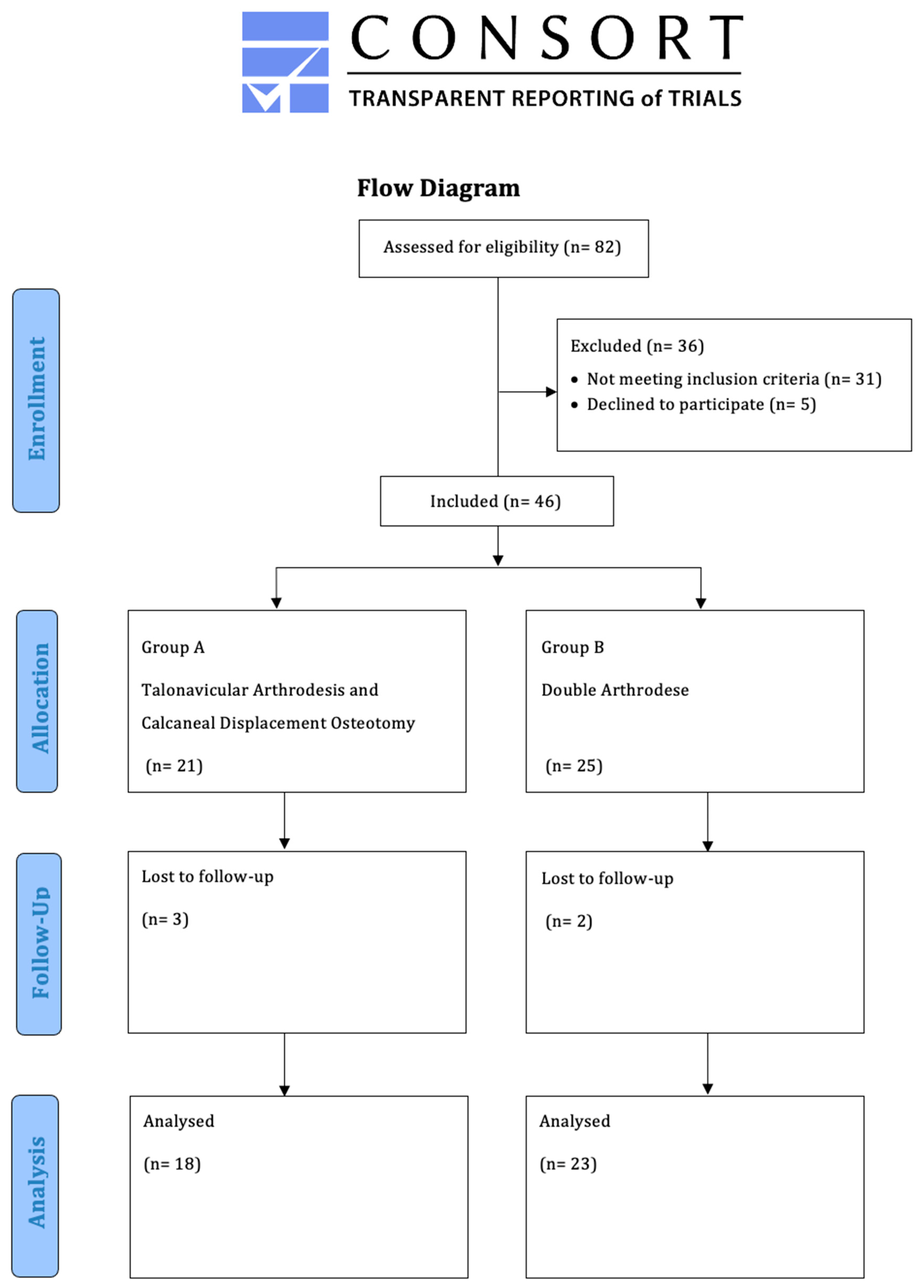
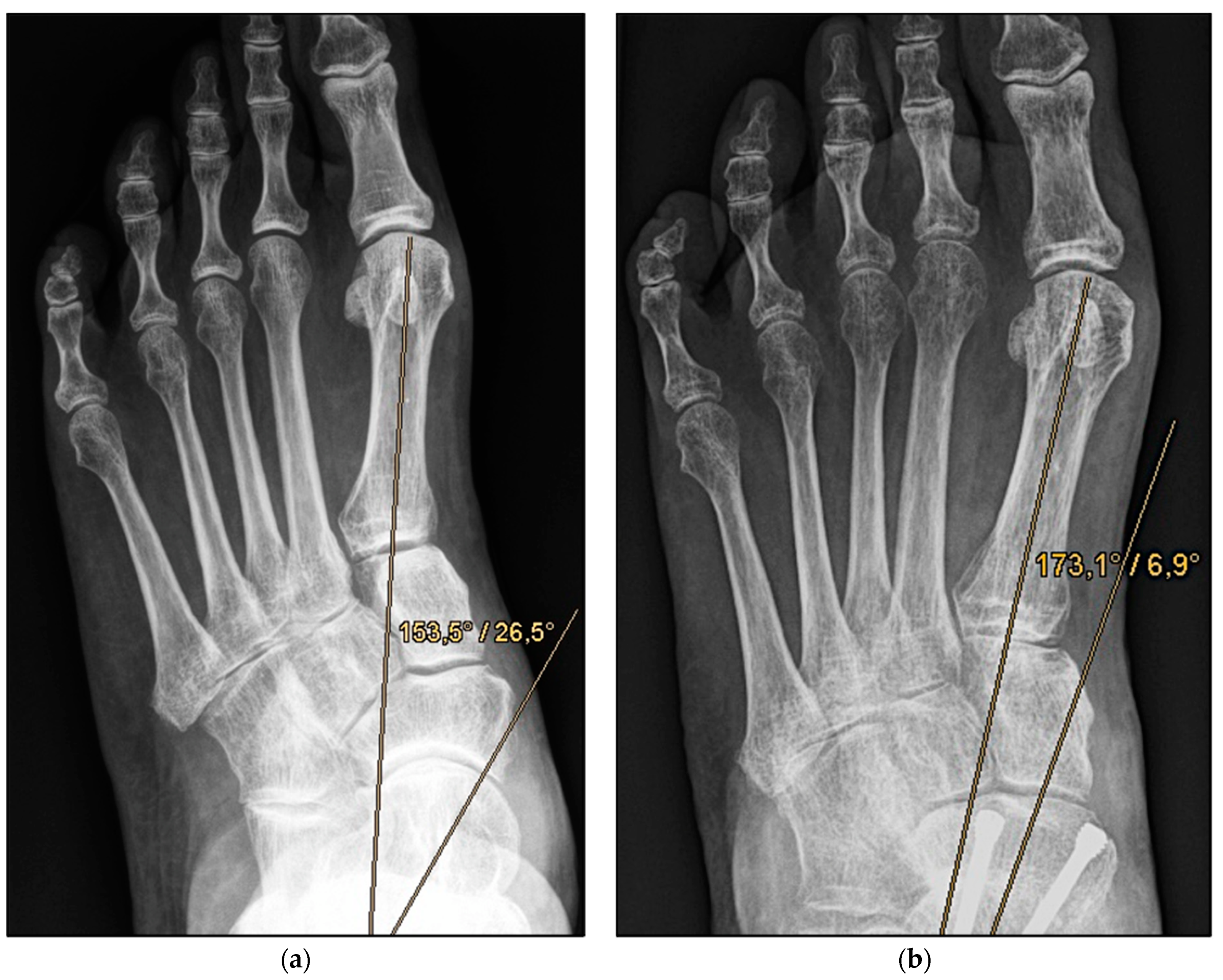

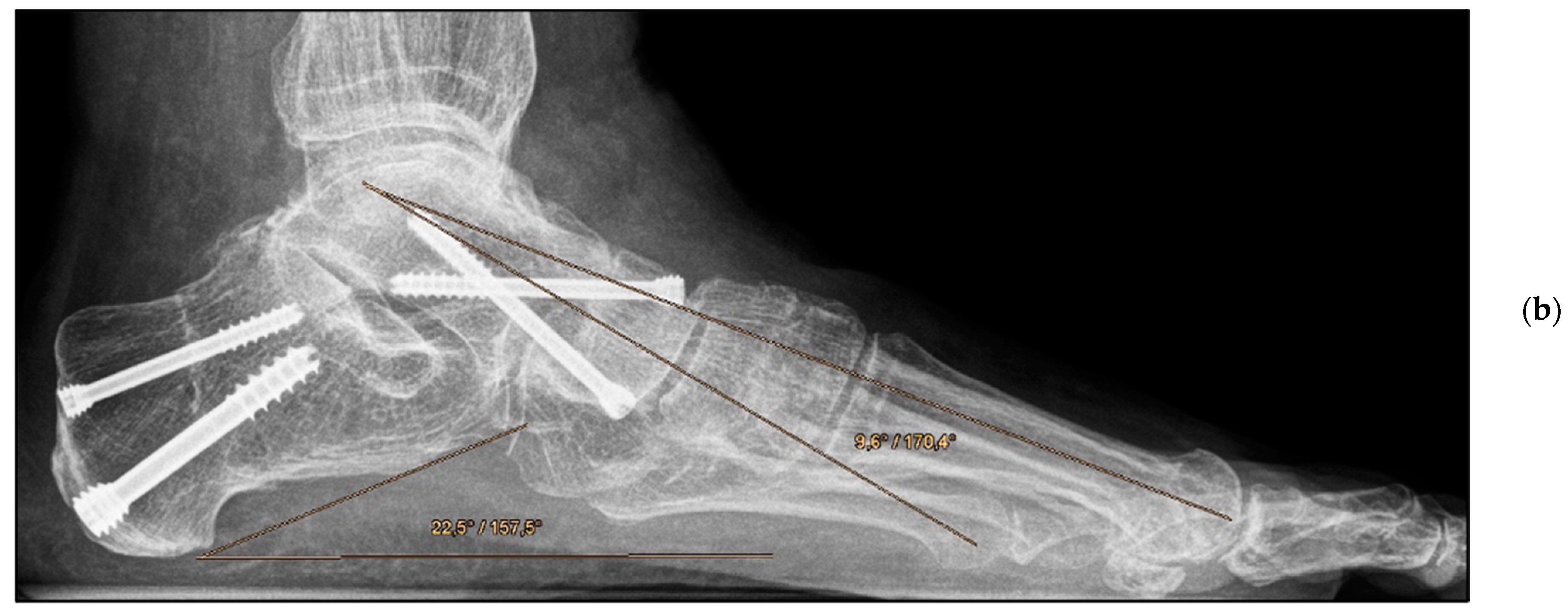

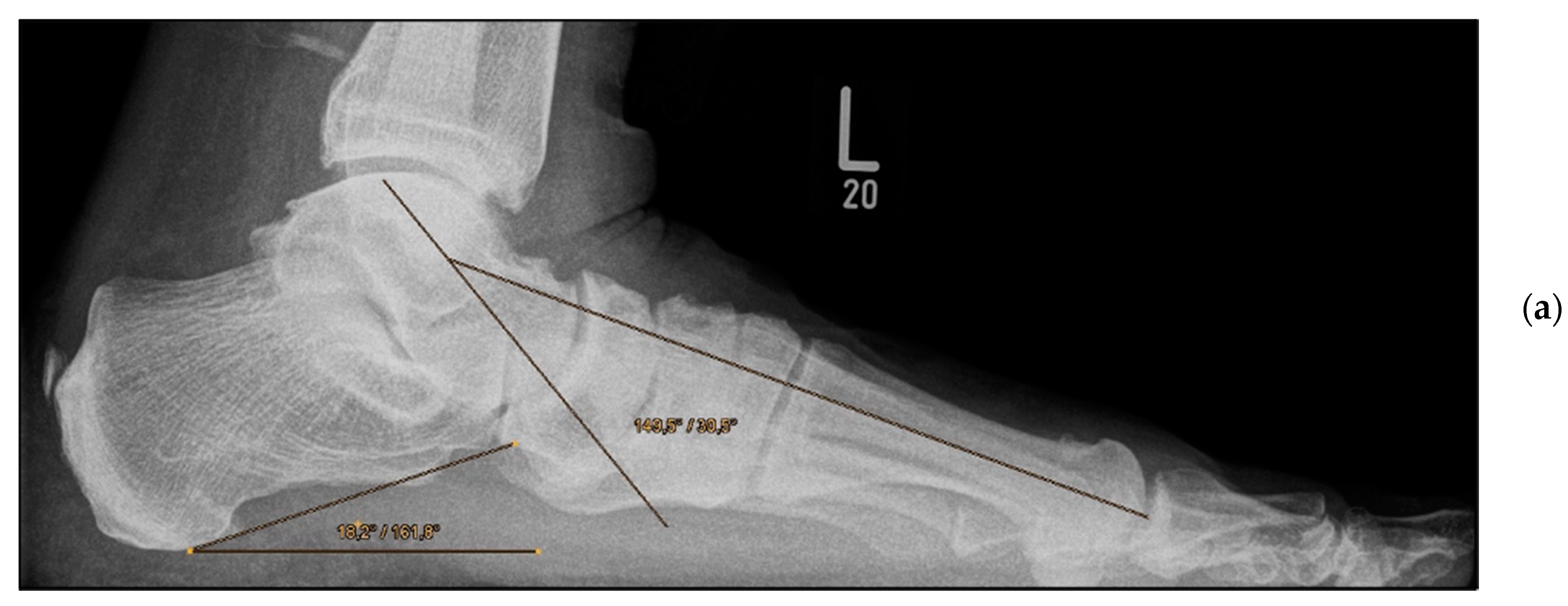
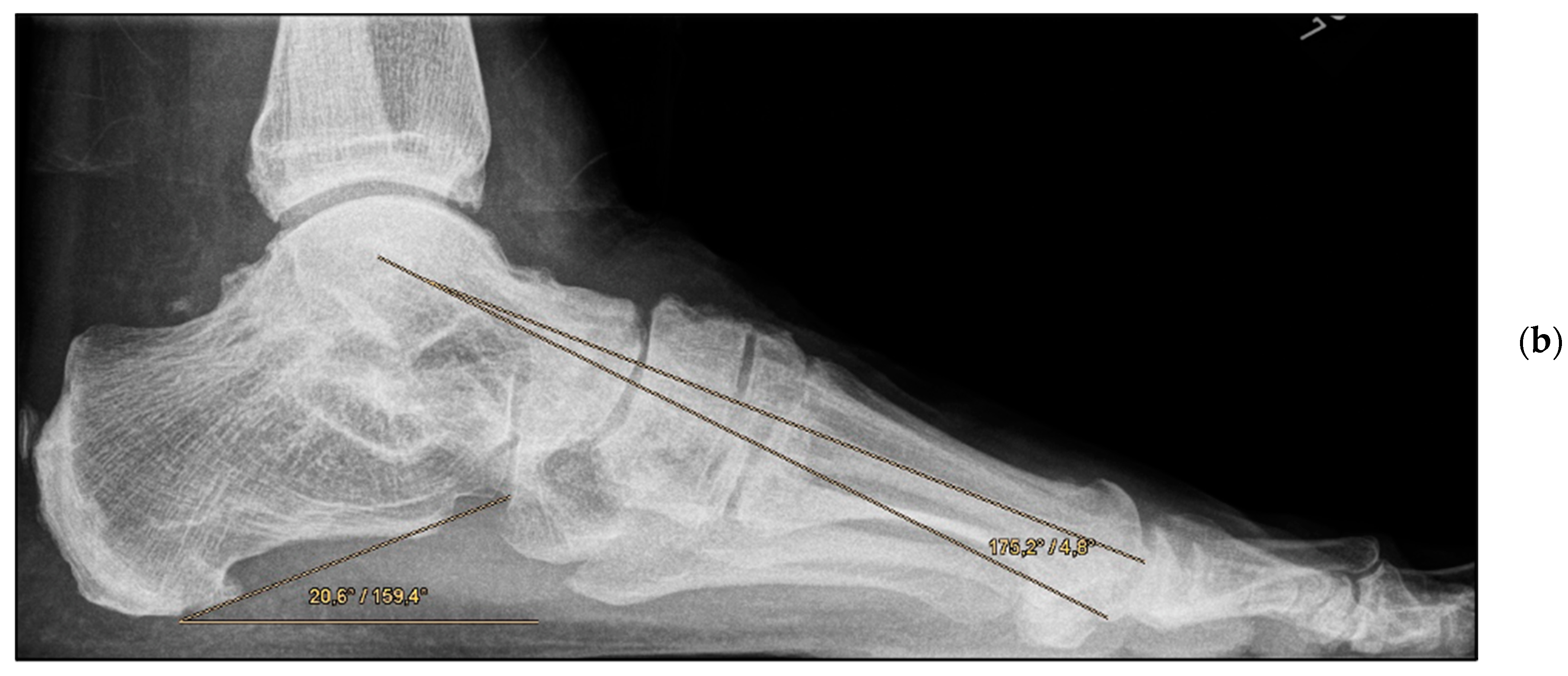
| Characteristic | Group A (n = 18) | Group B (n = 23) | All (n = 41) | p |
|---|---|---|---|---|
| Age, years | ||||
| Mean | 60.06 | 66.04 | 63.42 | 0.073 |
| SEM | 2.22 | 2.29 | 1.66 | |
| Minimum | 45.00 | 35.00 | 35.00 | |
| Maximum | 78.00 | 81.00 | 81.00 | |
| Sex | ||||
| Male, n (%) | 4 (22.2) | 9 (39.1) | 13 (31.7) | 0.259 |
| Female, n (%) | 14 (77.8) | 14 (60.9) | 28 (68.3) | |
| BMI, kg/m2 | ||||
| Mean | 27.55 | 28.35 | 28.00 | 0.548 |
| SEM | 0.86 | 0.94 | 0.65 | |
| Minimum | 21.80 | 21.60 | 21.60 | |
| Maximum | 35.40 | 36.90 | 36.90 | |
| Affected side | ||||
| Left, n (%) | 12 (66.7) | 15 (65.2) | 27 (65.9) | 0.925 |
| Right, n (%) | 6 (33.3) | 8 (34.8) | 14 (34.1) | |
| Smoker | ||||
| Yes, n (%) | 10 (55.6) | 5 (21.7) | 15 (36.6) | 0.026 |
| No, n (%) | 8 (44.4) | 18 (78.3) | 26 (63.4) | |
| Pre-existing conditions | ||||
| Metabolic syndrome-associated, n (%) | 6 (33.3) | 17 (73.9) | 23 (56.1) | 0.018 |
| Others, n (%) | 8 (44.5) | 4 (17.4) | 12 (29.3) | |
| None, n (%) | 4 (22.2) | 2 (8.7) | 6 (14.6) | |
| Orthopaedic insoles, n (%) | ||||
| Only pre-operative | 2 (11.1) | 0 (0.00) | 2 (4.9) | |
| Only post-operative | 3 (16.7) | 4 (17.4) | 7 (17.1) | |
| Pre- and post-operative | 13 (72.2) | 18 (78.3) | 31 (75.6) | |
| Never | 0 (0.00) | 1 (4.3) | 1 (2.4) |
| Measurement | Group A (n = 18) | Group B (n = 23) | All (n = 41) | p |
|---|---|---|---|---|
| Pre-operative | ||||
| AP talocalcaneal angle in degrees | ||||
| Mean (range) | 34.5 (23.0–47.0) | 31.6 (17.0–45.0) | 32.9 (17.0–47.0) | 0.223 |
| SEM | 1.61 | 1.64 | 1.17 | |
| AP talo–first metatarsal angle in degrees | ||||
| Mean (range) | 25.8 (15.0–36.0) | 25.2 (7.0–42.0) | 25.5 (7.0–42.0) | 0.831 |
| SEM | 1.68 | 2.16 | 1.40 | |
| Talonavicular coverage angle in degrees | ||||
| Mean (range) | 32.8 (17.0–51.0) | 31.7 (20.0–50.0) | 32.2 (17.0–51.0) | 0.714 |
| Minimum | 2.09 | 1.88 | 1.38 | |
| Lateral talocalcaneal angle in degrees | ||||
| Mean (range) | 62.1 (45.0–70.0) | 58.7 (38.0–71.0) | 60.2 (38.0–71.0) | 0.208 |
| SEM | 1.52 | 2.03 | 1.32 | |
| Meary’s angle in degrees | ||||
| Mean (range) | 30.4 (14.0–53.0) | 29.1 (11.0–49.0) | 29.7 (11.0–53.0) | 0.700 |
| SEM | 2.22 | 2.55 | 1.71 | |
| Post-operative | ||||
| AP talocalcaneal angle in degrees | ||||
| Mean (range) | 23.2 (17.0–35.0) | 20.6 (7.0–30.0) | 21.7 (7.0–35.0) | 0.180 |
| SEM | 1.32 | 1.36 | 0.97 | |
| AP talo–first metatarsal angle in degrees | ||||
| Mean (range) | 6.4 (0.0–20.0) | 8.7 (0.0–22.0) | 7.5 (0.0–22.0) | 0.333 |
| SEM | 1.47 | 1.84 | 1.17 | |
| Lateral talocalcaneal angle in degrees | ||||
| Mean (range) | 50.5 (39.0–62.0) | 46.1 (39.0–55) | 48.1 (39.0–62.0) | 0.047 |
| SEM | 1.77 | 1.24 | 1.10 | |
| Meary’s angle in degrees | ||||
| Mean (range) | 11.3 (0.0–19.0) | 11.2 (0.0–28.0) | 11.2 (0.0–28.0) | 0.985 |
| SEM | 1.34 | 1.65 | 1.08 |
| Measurements | Group A (n = 18) | Group B (n = 23) | All (n = 41) | p |
|---|---|---|---|---|
| FFI-D (18 items) | ||||
| Mean | 34.45 | 33.51 | 33.93 | 0.897 |
| SEM | 5.53 | 4.71 | 3.54 | |
| Minimum | 1.23 | 3.09 | 1.23 | |
| Maximum | 78.40 | 89.51 | 89.51 | |
| FFI-D pain subscale (8 items) | ||||
| Mean | 29.12 | 21.64 | 24.92 | 0.333 |
| SEM | 5.42 | 5.26 | 3.79 | |
| Minimum | 0.00 | 0.00 | 0.00 | |
| Maximum | 71.43 | 84.72 | 84.72 | |
| FFI-D disability subscale (10 items) | ||||
| Mean | 38.36 | 43.38 | 41.17 | 0.532 |
| SEM | 6.15 | 5.16 | 3.93 | |
| Minimum | 0.00 | 5.56 | 0.00 | |
| Maximum | 85.56 | 93.33 | 93.33 | |
| SF-12 (Physical component summary) | ||||
| Mean | 40.91 | 44.87 | 43.13 | 0.243 |
| SEM | 2.51 | 2.22 | 1.67 | |
| Minimum | 25.82 | 13.27 | 13.27 | |
| Maximum | 58.10 | 59.46 | 59.46 | |
| SF-12 (Mental component summary) | ||||
| Mean | 40.91 | 44.87 | 43.13 | 0.059 |
| SEM | 2.51 | 2.22 | 1.67 | |
| Minimum | 25.82 | 13.27 | 13.27 | |
| Maximum | 58.10 | 59.46 | 59.46 |
Publisher’s Note: MDPI stays neutral with regard to jurisdictional claims in published maps and institutional affiliations. |
© 2022 by the authors. Licensee MDPI, Basel, Switzerland. This article is an open access article distributed under the terms and conditions of the Creative Commons Attribution (CC BY) license (https://creativecommons.org/licenses/by/4.0/).
Share and Cite
Fischer, S.; Oepping, J.; Altmeppen, J.; Gramlich, Y.; Neun, O.; Manegold, S.; Hoffmann, R. Adult-Acquired Flatfoot Deformity: Combined Talonavicular Arthrodesis and Calcaneal Displacement Osteotomy versus Double Arthrodesis. J. Clin. Med. 2022, 11, 840. https://doi.org/10.3390/jcm11030840
Fischer S, Oepping J, Altmeppen J, Gramlich Y, Neun O, Manegold S, Hoffmann R. Adult-Acquired Flatfoot Deformity: Combined Talonavicular Arthrodesis and Calcaneal Displacement Osteotomy versus Double Arthrodesis. Journal of Clinical Medicine. 2022; 11(3):840. https://doi.org/10.3390/jcm11030840
Chicago/Turabian StyleFischer, Sebastian, Julia Oepping, Jan Altmeppen, Yves Gramlich, Oliver Neun, Sebastian Manegold, and Reinhard Hoffmann. 2022. "Adult-Acquired Flatfoot Deformity: Combined Talonavicular Arthrodesis and Calcaneal Displacement Osteotomy versus Double Arthrodesis" Journal of Clinical Medicine 11, no. 3: 840. https://doi.org/10.3390/jcm11030840
APA StyleFischer, S., Oepping, J., Altmeppen, J., Gramlich, Y., Neun, O., Manegold, S., & Hoffmann, R. (2022). Adult-Acquired Flatfoot Deformity: Combined Talonavicular Arthrodesis and Calcaneal Displacement Osteotomy versus Double Arthrodesis. Journal of Clinical Medicine, 11(3), 840. https://doi.org/10.3390/jcm11030840







